#hairless mammals
Text
The Adventures Of Pinocchio 1883 Review Ch 13-18
chapter 13
Cat says he feels weak and proceeds to eat unholy amounts of cheese. Fox sats he's on a diet, proceeds to eat all possible meat available in Italy.
Crickets ghost appears and says some typical
The Cat receives a telegram that his firstborn is dying from chilblains, dark much?
talking cricket stuff, "I want to give you some good advice blablabla..." something like that
Chapter 14
Pinocchio has a tongue, I think this was mentioned before but it's weird, right? He also eats things, I just don't quite understand his biology. Pinocchio thinks he can defeat assassins with words, such a pinocchio moment he is stupid. The assassins are very clearly the fox and cat from earlier and are just regular crooks not assassins, right? They wouldn't kill anyone
Chapter 15
I was wrong they would kill someone.
Creepy little blue haired girl won't let pinocchio in her home because she is dead and waiting for her coffin, dead people can't talk this is confusing. The assassins stab pinocchio obviously this doesn't do anything because he's wooden so then the assassins hang pinocchio, yes they hang him with a noose on a tree, and no pinocchio is not invulnerable to suffocating, he does survive but it says "death was creeping nearer and nearer" so despite his wooden neck he is definitely slowly dying .
Chapter 16
Pinocchio is saved by the blue hair girl, it's revealed she's some old fairy I think this is the Blue Fairy who I know of vaguely. Then my favourite character yet is revealed, Medoro the Poodle, I’ll make a seperate post about him. Then the doctors arrive and one of them is The Talking Cricket, I've now just realised why is he called the talking cricket but other talking animals don't have talking in their title, is he the last of his kind? I also love the other doctors observations, Dr owl basically says he's dead but if he's alive then that's proof he's alive" and Dr crow says he's alive but if he was dead that would be proof that he's dead
Chapter 17
This whole chapter is just telling kids to take medicine when they're sick and not be a stupid baby and die from illness because they didn't take their medicine. Just a life lesson for kids I guess. Oh also this the chapter when his nose starts growing. The fairy explains "there are two kinds of lies, lies with short legs and lies with long noses" this does not explain anything
Chapter 18
So pinocchio's nose grew rather long, how do you think it gets back to normal? The fairy summons a thousand woodpeckers of course.
This fox and cat are such a bad influence.
The city of simple Simon's is filled with hairless mammals, combless chickens, colourless butterflies (which means they can’t fly because obviously its the colour not the wings that make them fly) and etc.
#pinocchio#classic literature#fantasy#chilblains#cricket#long nose#hairless mammals#dark fantasy#murder#blue fairy#fairy#fairytale#fairytales
0 notes
Text

the greatest form of life in the observable universe is going to raze your stupid civilisation to the ground
#spore 2008#spore#grox#im not 100% on this design for them i think i want to adjust the face and head a little theyre too earth-mammal + friendly looking#the body is pretty much exactly what i was going for though i like the idea of them having a thick fleshy husk of sorts on only their torso#less like a crustacean more like a hairless hedgehog or a seal. no hard shell but a very very thick layer of dense fat and thick skin#no long silky fur also their hair has about as much density and cover as a pachyderm. very fine. all that colour is just pigmented skin#my art#also i like the idea of them being comparatively tiny and not particularly hardy compared to the relative size of most sophonts
293 notes
·
View notes
Text
Truly a missed opportunity to never have Lae'zel use "hairless mammal" in plaxe of another character's name like she's a penguin of Madagascar.
#valk yelling at clouds#Had a vision of her glaring at shadowheart or w/e and going#You hairless mammal i require your assistance
10 notes
·
View notes
Text
If we weren't humans but humans were still another kind of animal found in the wild, people would totally be like "ew why is it so hairless"
#humans need to GET HAIRIER#you see how people react to other hairless/mostly-hairless mammals already#chinese crested / sphynx cat / naked mole rat etc#although I guess marine mammals and certain megafauna like elephants/hippos/rhinos are exempt#but compare us to other apes and we're all weird looking and bald
39 notes
·
View notes
Text
#real talk or whatever but this webbed site has made me sooo much more comfy about having body hair like every now and then i'll get pissed off at my endocrine system then see someone talking about how it's normal and natural and expecting women to wax/shave/laser is completely backwards and i'm like. it's okay i'm okay!!!!
#bodily autonomy or whatever but sometimes i'll see a totally hairless woman out and about and i'm like baby girl you're a mammal it's okay#like it's fine to have hair!!!!#.txt
3 notes
·
View notes
Text
why yes i DO have to draw the body hair on Every Single Human I Draw
#all the care guide says is 'biomass'#STOP MAKING THEM HAIRLESS#I NEED THE FUZZY HUMANS THE HAIRLESS HUMANS ARE AWFUL TO DRAW#HAIRLESS HUMANS ARE NOT GOOD ART#WHY MAKE US MAMMALS IF NOT TO REVEL IN THE FUZZ
3 notes
·
View notes
Text
death to the hairless twink transition goals ideal. i am embracing the katmai tradition and competing to become the biggest bear. i'm gonna have the hairiest legs and fattest fupa you've ever seen. and i'm gonna love EVERY FUCKING SECOND OF IT
#sick of people commenting on my appearance#I'M NOT GETTING UGLIER BARBARA I JUST LOOK LIKE THE MAMMAL I AM INSTEAD OF A GODDAMN MANNEQUIN NOW#also sick of trans masc rep always being skinny hairless white boys
1 note
·
View note
Text
Received an incredible email from someone at the Museum of Natural History regarding Nellie, one of the first hairless cats ever photographed

“I did some digging into the museum records and found that we are still caring for Nellie's remains after all these years.
Unfortunately, as is sadly too common with old museums, most of her history had been lost over the past hundred+ years and was no longer a part of her records. However, because of your video I was able to pull together documentation from your sources and sent them along to the person in charge of the mammal collections and we have added her history back into the records. It is possible that without your video Nellie's history may have been lost forever, and that her body may have remained labeled with a simple number and not by her name. Now she has both.”
This is her public record (cw: 116 year old cat body): https://collections.nmnh.si.edu/search/mammals/?ark=ark:/65665/30bc945ca8ce94a97a4d453ea2b051b96
This is so cool!!!! We found her after like 100+ years!!!!!!!!!! AHHHHH
8K notes
·
View notes
Text
>by far most hairless species of primate
>is one of two primate species that willingly live in snow with the other being the Japanese macaque which is covered in thick hair
>is one of two mammal species that willingly eat spicy foods
>unlike tree shrews doesn’t have a special genetic mutation that makes spicy food not painful to eat
697 notes
·
View notes
Text
i think nearly everything about human behavior can be explained by our evolutionary background. if we observe the entire tree of mammal phylogenetics we can see that the glires clade (rodents and lagomorphs) and euarchonta (primates, colugos and treeshrews) are grouped into one superorder called euarchontoglires, meaning humans are also technically tree dwelling mice as far as semantics are concerned. anyways there are a lot of morphological similarities one can observe between rodents and primates, namely hands, and using those hands to hold onto something like a sunflower seed or a sandwich and nibble on it while sitting in a comfortable spot. like primates the ears, hands and feet of rodents are also relatively hairless, and they are also hypersocial and studies on rats have suggested they feel empathy and will act upon it. in fact a lot of rat behavior resembles human behavior to the point that many behavioral studies are done on them in order to understand the effects/causes of addiction and isolation etc. of course all these traits developed independently but one could argue that A) the basal form that euarchontoglires originated from was already predisposed to these traits or B) already had some or all these traits in varying quantities and other groups like lagomorphs actually lost them. so the homo genus finally developing visual art as one of the culminations of animal creativity/dexterity and immediately using that skill to animate little rodent people wearing clothes and living in societies parallel to our own over and over and over and over until we are sick of seeing them and wondering wtf is going on just makes perfect sense evolutionarily speaking. it was meant to be
204 notes
·
View notes
Note
Would Morell shave you /allow you to shave yourself in the early stages of the “relationship”. This is like the primary worry I would have (instead of the looming threat of being eaten)
Morell forgets about a lot of things.
He forgot you menstruate.
He forgets humans require special products for their hair, that they're fickle creatures who, much like a pretty indoor flower, wilt without the proper care.
He's not entirely heartless however, just tell him what you need. And provided you haven't been making Morell's life harder, he'll get you whatever you want.
Shroom monsters are vastly hairless. Sure, there's some mushrooms out there with silky caps or filaments, but they generally don't have hair. This means that his perception of body hair is pretty neutral. If you start growing extra hair on your legs or face he just finds it interesting and moves on. It's not a problem for him, piggies are mammals, and mammals tend to have body hair/fur. You'll have to explicitly tell him it makes you uncomfortable to have body hair in certain areas.
Depending on how well behaved you have been so far, you may or may not have the privilege of shaving yourself. The chef isn't about to trust you with something sharp if he knows you're prone to outbursts. Shaving you is a curious experience, and he may chuckle about it once or twice.
114 notes
·
View notes
Text
A thought experiment
Imagine you are trying to control populations of a non-native mammal species. If uncontrolled, they will overrun the carrying capacity of their habitat. This will cause the animals in question to suffer as they starve or sicken, and make it harder for native species to compete for the food and water they need.
What population control method do you reach for first? Remember you have limited funds and time.
For the purposes of this post, you don't get to know anything else about the mammal.
70 notes
·
View notes
Text
okay! so i’ve been watching a lot of smiling friends. and it would be out of character for me to watch something without doing some sort of intense hyper analysis. so here’s my thoughts on the biological classifications of the critters, humans, and maybe some other species of the smiling friends universe. my friend said this is how sheldon cooper would enjoy smiling friends. and i guess he’s right it’s very scientific. please read on.
first. we look at the wiki. who is defined as a critter? for this analysis, the specific characters that are designated as critters on the wiki i’ll be looking at are charlie, pim, allan, glep, dj spit, and mr landlord. so first, let’s take a look at the anatomical features of each of these characters.
charlie:

- large protruding nose
- eyes on the front of his head (i think?)
- head and some body hair (chest, stomach)
- 4 fingers
- primary and secondary sex characteristics (nipples and genitalia)
- belly button
- average height
- 27 years old
pim:

- no visible nose
- eyes on front of head
- no hair, one exposed nerve ending
- four fingers
- secondary sex characteristics (nipples) and presumably primary (genitals) given the fact that he is always clothed
- belly button
- short
- 34 years old
allan:

- smaller but still protruding nose
- eyes on sides of head
- no hair
- four fingers
- no visible sex characteristics, no clothing required, occasionally to accessorize (tie, bathing suit, floral vacation clothing)
- no belly button
- tall
- 24 years old
glep:

- can’t tell if he has a nose or if it’s just his upper jaw tbh
- eyes on side of head
- no hair
- no fingers
- no visible sex characteristics, only wears a hat
- no belly button
- incredibly short
- 1295 years old
dj spit:

- prominent nose
- eyes on front of head
- facial and body hair
- no fingers
- secondary sex characteristics (nipples) and presumably primary (pants covering lower half)
- no belly button (as far as i can tell)
- average height
- 23 years old
mr. landlord:

- prominent nose
- eyes on front of head
- hair on head
- four fingers
- no visible sex characteristics, does not usually wear clothes
- belly button
- tall
- unknown age
now. that’s a lot of variation! in My humble opinion i feel like that’s enough to designate different species since there is so much different between some of them, especially in the case of a lack of visible sex characteristics and the presence of nipples/a bellybutton, since the latter are distinct signs of a place tal mammal. however, regardless of what i think, it’s clear that there’s a significant amount of genetic variation in this population. what could have caused this?
theories:
here is what i and a few others who i’ve asked have come up with. scroll down to theory four to see the one i think is most likely, and therefore did the most research/explaination for.
theory one: there is no meaning to any of it and there is no pattern. they look the way they do because it is funny. is this a realistic take? yeah. do i like it? no. it’s boring. so i’m disregarding it.
theory two: the critters are just a species with an incredible amount of genetic variation. i guess this is possible and kind of goes with the first theory but there’s a little more nuance to it so i’m including it as a separate theory. again i keep going back to how i wish there was more specification, like certain breeds or races. different races, though, like the spamtopians, seem to be treated as completely different species. although they also have a lot of genetic diversity. additionally, many of the humans don’t look the same/have the same traits. so maybe there’s just high levels of diversity in each species, and there are other ways they’re each distinctly classified.
theory three: convergent evolution from a few different base species. this one could very well be the truth. several of the critters bear more resemblance to reptiles or amphibians, particularly the ones that are hairless and possess no visible sex characteristics. allan definitely has some lizard-esque characteristics, especially looking at the shape of his eyes, and pim kind of reminds me of a frog, and he does in fact refer to his youth as when he was “a tadpole”. glep also reminds me of a small lizard. the more mammalian critters, like charlie, could also have evolved from apes as humans did. maybe charlie and his big schnozz are distantly descended from a proboscis monkey. and dj spit from. something else ape like. idk. i definitely don’t know what to say about mr. landlord. he has some mammalian characteristics (hair, bellybutton) but he also lacks the sex characteristics. he could be the result of some intermixing but i’m truly not sure. additionally, some of the critters have forward facing eyes (typically indicative of a predator species), while some have eyes on the sides of their heads (typically indicative of a prey species). now, this rule does have exceptions, but i do think the possibility that pim is a predator animal is really funny. this one has its merits, but i don’t see why they wouldn’t be just split into different species at that point if there are distinctly reptilian vs mammalian groups, and the existence of those who are sort of in between, like mr landlord, adds to the confusion. additionally, it fails to account for how the critters all seem able to breed with/have relationships with characters classified as humans, because if there are some that are distinctly more reptilian than the more mammalian critters, it’s so incredibly unlikely that the reptilian descendants would be able to breed with humans, since, at least in our universe, humans cannot even breed with other mammals, so there’d have to be something going on for a primarily reptilian species to breed with humans.
theory four: all the critters we see, with a few exceptions, are a result of many generations of human/critter crossbreeding. this is the one that i am rooting for, and it makes the most sense to me. between all the critters, we can definitely see some that have more human traits, and some that have more animalistic traits. so, maybe charlie and dj spit have more human dna, whereas, say, allan and glep have more critter dna in their lineage. again, we do know that human/critter relationships are very commonplace, as both glep and charlie have human partners. in my opinion, it seems that glep is furthest on the critter spectrum, given his lack of any distinct human characteristics and incredibly high age. he could be one of the last remaining true Critters. on the other end, dj spit appears to be the most human. all the others fall in between.
additionally, many of the human characters don’t display Only humanoid traits. some are live action, some are rotoscoped, and some are traditionally animated. the different ways they’re animated (or distinctly Not animated) seems to indicate a little bit of genetic diversity as well. for example, mr boss is animated, and switches from five to four fingers, and has the ability to turn his face into a dog face. i guess there’s no proof none of the other humans can do that, but he does seem to be a little more non-human, when we take that into account along with his disproportionate features (eg. massive head). and i’m not even gonna open up the can of worms that is the fact that sometimes he has massive bazonkers that he can nurse jason with, and sometimes just has pecs. additionally, we can see that doug and professor psychotic, while presumably biological brothers, have a lot of different characteristics, with doug being rotoscoped, and professor psychotic being animated and honestly sharing more characteristics with dj spit (a critter) than his own brother. someone also pointed out that their mother may be spamtopian, as she looks like the waitress that pim and mr boss encountered on their visit to spamtopia. so, we can divide the humans into four groups, going from least to most human.
- wacky/slightly inhuman animated person (mr boss, professor psychotic, desmond, etc)

- regular looking animated person (zoey, marge simpson, etc)

- rotoscoped person (doug, etc)
(i cant find a good picture just go watch the show)
- live action person (president jimble, tyler, simon s. salty, etc)
(you know what a human being looks like.)
now there’s one thing that kinda throws a wrench in this theory: jason. jason is the son of mr boss and an unknown mother, presumably a critter. jason, while being the son of a character that is classified a human, looks the most like glep: meaning that he displays some of the most critter characteristics when compared to any other characters. additionally, he seems to share glep’s aging patterns, being 18 years old and still a nursing baby. so if he’s definitely part human, and appears like glep, maybe glep isn’t a full critter after all. HOWEVER. the way i have elected to combat this is through the use of a punnet square.

now, if H is the allele for presenting like a human, and C is for presenting like a critter, we can see that a half human half critter, when mixed with a whole critter, will produce offspring that are fully critter 50% of the time. now, with the amount of different critters that have varying amounts of human traits, we can assume that it’s a lot more complicated than two genes. but, if all the genes weigh together, it is definitely possible for jason to have inherited mostly his father’s critter dna instead of his human dna, which, when paired with his mother’s full critter dna, resulted in him looking like a pure critter, like glep. yknow, like how some dogs are mixes but they look exactly like one parent rather than the other. now of course, jason doesn’t stay this way, and ends up growing wings and all that jazz, which could be a result of the variant dna, showing that while he may initially look fully critter and age like one, some traits may emerge as he matures that show his differences.
so, to conclude this theory, here is what i think the spectrum of critter -> human is, and where the line between the two is drawn.

now yes, this is a simplification and does not account for any interbreeding between the less common non human/non critter species, such as spamtopians, demons, sentient animals, forest folk, and so on and so forth. but i think it covers the most likely line of progression between the two species and how they’ve presumably mixed over time, with more input from the less popular species as aforementioned.
thanks for listening like and follow for more overanalysis of stupid things.
#smiling friends#matty’s media essays#charlie dompler#charlie smiling friends#charlie sf#pim pimling#pim smiling friends#pim sf#charpim#allan red#allan smiling friends#allan sf#mr boss smiling friends#jason smiling friends#marge simpson#zoey smiling friends#adult swim#smiling critters#critters#humans#critter#taxonomy#biology#classifications#evolution
107 notes
·
View notes
Text
This post can be found in my devArt, (link), please use that for linking if you need the reference, thank you!
Wingbeans
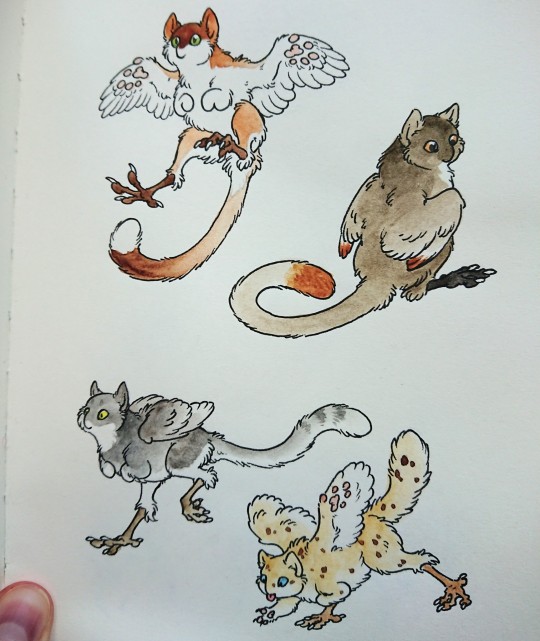
The funny little griffin-y things colloquially known as wingbeans are flightless, roughly cat-sized, seemingly mammalian creatures with curious nature.
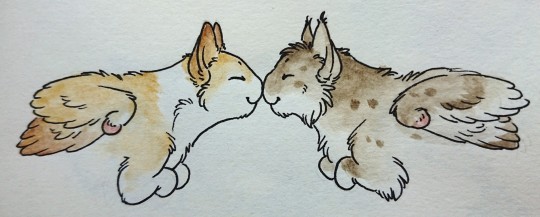
They resemble bipedal cats with chicken feet, but not quite. They are usually covered in soft, floofy fur, except for their hind legs and pawpads. They have soft snoot covering their mouths, which they will boop into things and people they like. Snoot bumps are their way of saying hello.
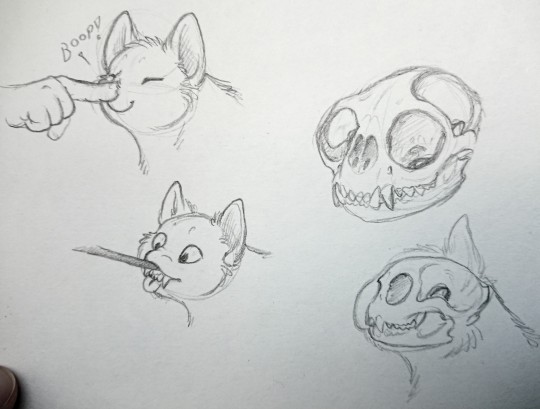
They have big, bright eyes with vertical slit pupils, and their nostrils are hidden beneath the floof of the snoot. They trust their sight and hearing more than their sense of smell.

They have short arms with three fingers, that are usually held tucked against their chest. The fingers usually have hidden cat claws.
Their wings are small and covered in soft, fluffy feathers, that are used mostly as display and as an additional pair of arms when climbing. The wings have five fingers in a fluff mitten, each having a paw pad, which is where the name wingbean comes from. In a wild type 'bean only the thumb of the wing has a retractable claw, like a cat, to use as climbing grip and for defence.
Their legs are usually hairless from ankle down, and have four toes, three pointing forwards and a small dewclaw pointing backwards. The foot claws are dull, and non-retractable.

They usually have long floofy tails, though there are short tailed and even bobtailed variations. It is also possible to have a tuft tipped tail.
Wingbeans are omnivorous, and as a species aren't picky about what they eat, though personal preferences vary wildly.
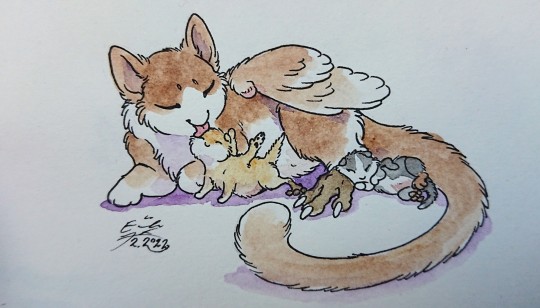
Wingbeans can have anywhere between 1 and 4 kittens (also called beanies or beanlings) at a time, most often 2. The kittens are born within a soft leathery egg shell, and they hatch usually within few hours after birth. They nurse their young like mammals.

Mom takes care of the kittens untill they're big enough to fend for themselves, though the offspring often stays nearby even as adults. The 'beans are social creatures who enjoy hanging out with friends, so big family groups (be they actually related or adopted) aren't unusual.
Wingbeans are considered fully grown at one year old, and in the wild their life span tends to be around 20 years, though domesticated 'beans can get a lot older.
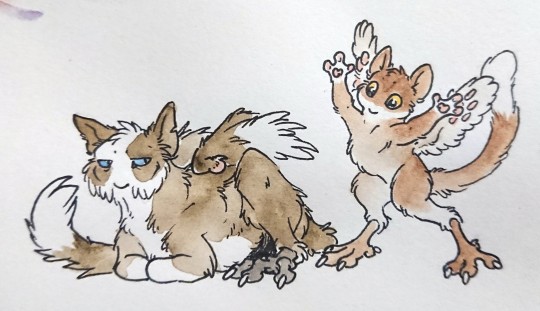
Wild wingbeans come in a wide variety of markings and their colors cover all shades of browns and grays, but some have been bred to display brighter colors and strange markings, including unnatural ones. All coat types and lengths are possible; short haired, long haired, curly coated, maned, etc.
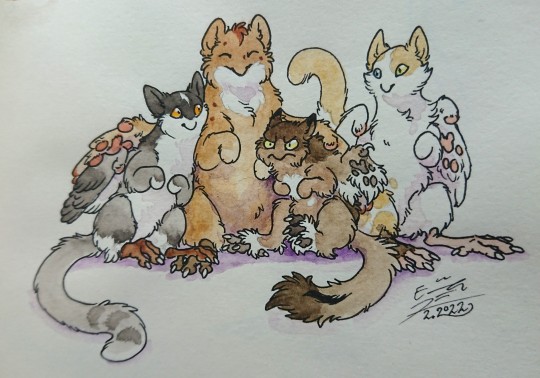
They have no apparent sexual dimorphism, and gender appears to be an optional feature to them.
Wingbeans are meant to be fun creatures, and to bring joy and fun.
Wingbeans are not meant for making money. They can be created freely, and they may be gifted, but they shall not be sold.
If you want to get rich by making weird little griffin-y things, make your own species.
Can I make my own wingbean?
Yes you can!
Can I make wingbean adoptables?
As long as you don't sell the designs for real life money. Giving them away for free, or trading them for virtual stuff such as virtual petsites' in-game currency, or things like art or poetry is fine.
Can I make wingbean NFTs/sell them for crypto stuff?
No.
Can I commission people to draw my wingbean?
Yes! Also, while wingbeans themselves aren't meant to be bought with money, do pay artists for the work they do. Artists need to eat too.
Can I commission an artist to design me a wingbean?
I'd say that still counts under the commission clause, so yes.
Can I use them in my D&D/TTRPG campaign?
Sounds fun, sure!
What if I want my wingbean to have rainbow colors?
Sure. Maybe your 'bean was bred by a wizard or something. Have fun!
Can my wingbean have raptor claws?
Sounds awesome. Go for it!
Can my wingbean have horns or other fancy details?
Did your 'bean wander in the way just as you were about to cast polymorph, didn't it?
You said they are flightless, but what if I want my wingbean to be able to fly?
Sounds like it was either born with bigger wings, or it can levitate. Either way sounds cool.
Can I make a wingbean of a big cat species?
That might stretch the definition of a wingbean, but if you feel like it's still wingbeany enough, then sure, go for it!
Do they have whiskers?
They can, if you want.
Are wingbean legs scaly like bird feet, or leathery?
Whichever you want. Both are good.
Are there any rare or limited features or markings?
The rarity of those depend entirely on what kinds of 'beans people create. If half the people making wingbeans decide to make theirs blue, then I guess blue isn't a rare color at that point, now is it?
But how will I know if my wingbean is special?
It's special because it's yours. No wingbean belongs behind paywalls.
What would a hairless wingbean look like?
Considerably less fluffy.
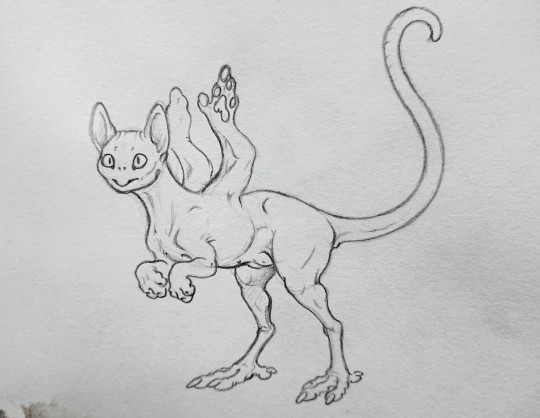
541 notes
·
View notes
Text
Dry Beast Monday: chinchillas
For over a year now I've been doing weekly Wet Beast Wednesday posts where I do a deep dive on some aquatic animal, and you know what? I'm tired of it! This is now a dry beast blog!* And where better to start than an animal that can literally die if it gets wet? Beasts can't get much dryer than that. So strap in for the first Dry Beast Monday... Dmonday?... Drunday? Whatever, it's the chinchilla.
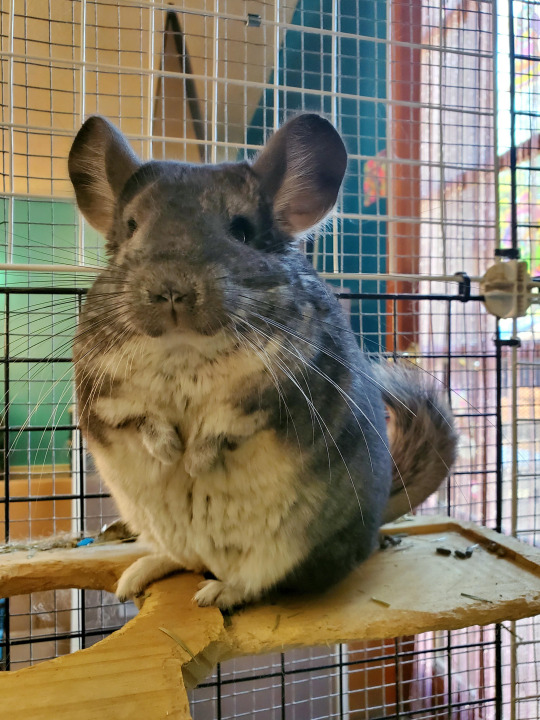
(Image: a pet chinchilla in a cage, standing upright on a wood platform that has been heavily chewed. It is a rotund mammal with a similar body plan to rabbits, featuring a large head distinct from a round body. Its hind paws are larger than the forepaws and have more distinct toes. Its eyes are almost completely black and it has a flat nose with very long whiskers. The ears are large, rounded, and mostly furless. The tail is bristly hair like a squirrel's and is curled up. Most of its fur is a dark grey but the fur on its underside is white. End ID)
Chinchillas are rodents (the best mammals, fight me) that are members of the family Chinchilladae along with the viscachas. There are two living species of chinchilla: the long-tailed chinchilla (Chinchilla lanigera) and the short-tailed chinchilla (Chinchilla chinchilla, formerly Chinchilla brevicaudata). The two species can produce sterile hybrid offspring. Domesticated chinchillas are descended from the long-tailed chinchilla. All chinchillas are medium-sized rodents with powerful back legs, long whiskers, large ears, and extremely dense fur. In comparison, the short-tailed chinchilla is larger and has a shorter tail, thicker and less distinct neck and shoulders, and smaller ears. The most famous feature of chinchillas is their fur. At about 20,000 hairs per square centimeter, chinchillas have the second densest fur of any mammal, second only to sea otters. Each hair follicle grows up to 50 hairs, compared to human follicles, which only grow 1. The fur is famous for being incredibly soft, often described as velvety. If you've never felt a chinchilla its really hard to describe just how soft they are. The fur is so dense because Chinchillas live in the highlands of the Andes mountains where it gets very cold. The fur is used for insulation and even with it being so thick, chinchillas still need to bask in the sun to warm themselves up. The fur is actually the reason why chinchillas can't get wet. Their fur is so dense that wanter can't evaporate easily, instead remaining around long enough for fungus to start growing in the fur. This can lead to a lot of different skin conditions and infections that can be lethal. When chinchillas bathe, they take dust baths. By rolling around in volcanic ash, the can work the ash into their fur, where it absorbs oils, moisture, and other contaminants. This keeps the fur clean and healthy. Domestic chinchillas need specially made dust for their baths. It cannot be substituted with sand or other materials. Chinchillas can release chunks of their fur in order to escape from predators, leaving the predator holding nothing but a tuft of hair while the chinchilla runs away. This is called fur drop and in domestic chinchillas it can be a sign of mishandling or stress. Wild chinchillas have grey fur, but domestic breeds have been bread to have other colors of fur, including white and black. Chinchillas can't sweat, which isn't a problem in their natural habitat, but is for domestic chinchillas. The only way for them to cool down is to expose their ears (which are hairless and heavily vascularized) to wind. Chinchillas in temperatures at or above 26 degrees C (80 F) are at risk of having heat strokes. Daytime in the Andes can exceed those temperatures, so chinchillas hide in burrows during the day. Chinchillas are very skilled at jumping, able to leap up to 1.8 meters (6 ft). Their hind legs are longer than the forelegs and provide propulsion when walking or jumping. The toes has fleshy pads called papillae that help them grip onto surfaces. Chinchillas live in arid, rocky conditions and are skilled at leaping between rocks. The tails act like rudders, providing stability and direction when leaping. The front feet are capable of gripping and picking up objects. Females tend to be larger than the males, but there is otherwise little visual difference between the sexes. Wild short-tailed chinchillas can reach 38 cm (including tail) and 800 grams while wild long-tailed chinchillas can reach 26 cm (including tail) and 450 grams. Domestic chinchillas can get up to twice the size of their wild relatives.

(Image: a wild long-tailed chinchilla sitting under a rock. Its body plan is the same as the pet chinchilla above, but its fur is a lighter grey End ID)

(Image: a short-tailed chinchilla in captivity. It has a less distinct neck than the long-tailed chinchilla, making it look like its head merges with the body. Its tail is shorter than that of the long-tailed chinchilla, making up about 1/5th of its length as compared to the long-tailed chinchilla's 1/3rd. End ID)
Chinchillas are social animals that live in colonies called herds that can reach up to 100 members. Females dominate the herds and can be aggressive toward each other, though physical fights are rare. The herd cooperates when finding food, always having at least one member acting as a lookout to spot predators while the rest feed. They communicate vocally, with 10 types of vocalizations on record for. Social behaviors include grooming, playing, and friendly nibbling of each other's ears. Pet chinchillas should never be kept alone. They should be in same-sex groups of at least 2. Chinchillas are crepuscular, active mostly at dawn and dusk. During the day and night, they are usually found hiding in burrows or crevices between rocks, where they can avoid predators and high or low temperatures. They are primarily herbivores, but will supplement their diets with insects and other bugs. Most of their diet consists of grasses, seeds, and succulents and cacti. Wild ones almost never drink water, instead getting all of their hydration from their food. Chinchilla digestive systems are fairly specialized to their food. Domestic chinchillas need special-formulated food and can only have wooden chew toys form certain species of wood. Fresh or dried fruit is good for a treat, but should not be a regular part of their diet as they have a lot of sugar. As with all rodents, the incisors grow continuously through the animal's entire life and need to be worn down by chewing on things.
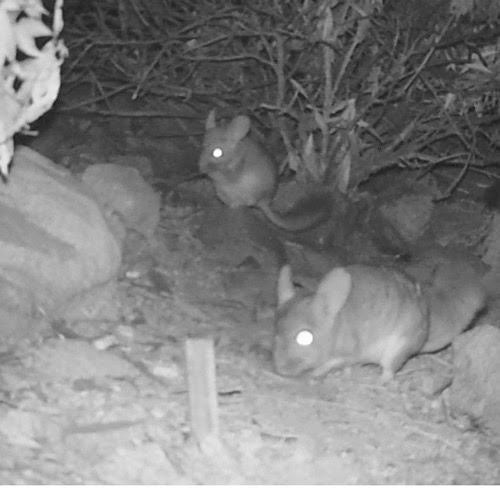
It is surprisingly hard to find good-quality images of wild chinchillas. Most of the time when you search for wild chinchilla pictures what you get are either domestic chinchillas or viscachas.
(Image: a trail-cam shot of two wild long-tailed chinchillas. The photo is i black-and-white. One is in the foreground on all fours while another is on its hind feet in the background, standing on a rock. The terrain is rocky and the chinchillas are next to a shrub. The camera's light makes their eyes appear to glow white. End ID)
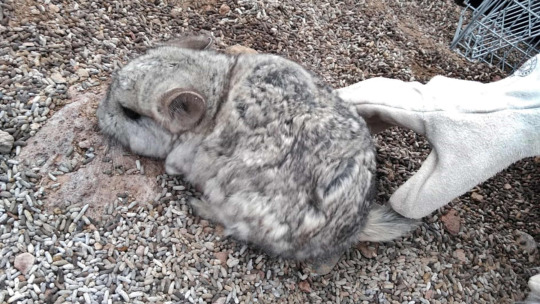
(Image: a wild short-tailed chinchilla that is part of a relocation effort. Its fur is light grey with darker patches. A gloved human hand is reaching in from the right side of the image. End ID)
Male chinchillas appear to be fertile year-round, but females only enter estrus during the winter, from May to November in their natural habitat. Gestation takes around 120 days in both species and both species typically have two litters a year (a low rate for a small mammal). Offspring (called kits) are born well-developed, with fur and open eyes, and can run as soon as they are born. They nurse for 6-8 weeks before being weaned. 1-6 kits are born at a time, with 2 being the usual number. Chinchillas are monogamous, mating for life. Either partner can initiate mating, which they do so with hair-pulling. Unusually for rodents, male chinchillas do provide care for their offspring. Members of the same herd will help each other with parenting. Female chinchillas have been known to adopt the kits of other females who can't nurse due to health issues. Females are usually dominant due to their size. Chinchillas become sexually mature at around 8 months. In the wild they can live for 10 years, which is doubled in captivity.
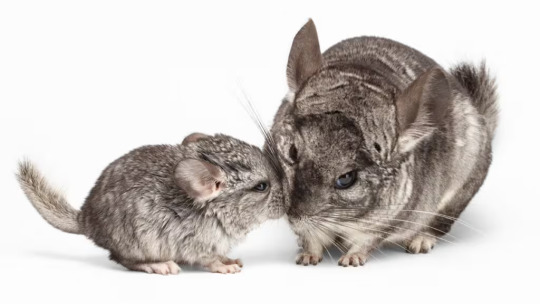
(Image: an adult domestic chinchilla with a juvenile. The juvenile is smaller than the adult, with proportionally larger head and limbs and proportionally smaller tail. The two of them are nuzzling their snouts together. End ID)
The name chinchilla comes from the Chincha people of the Andes, who hunted chinchillas for their fur and meat. This hunting increased vastly after European colonization of South America. Between hunting and trapping, both species of chinchilla were brought to near extinction and vastly reduced their native range. Both species are now only found in Chile and have been granted legal protection. The IUCN switched their classifications between Vulnerable, Endangered, and Critically Endangered for a while. As of 2016, both species are classified as Endangered, upgraded from Critically Endangered as their populations have seen some improvement. Poaching, both for fur and capture for sale as pets, is still a large threat to wild chinchillas. Their close cousins, the viscachas, are doing much better as they were not hit as hard by the fur trade. The domestication of the long-tailed chinchilla is thanks to Mathias F. Chapman, an engineer who became fascinated with the animals after meeting a native person who was trying to sell one. He ended up getting permission from the government of Chile to capture several and import them to the USA. It took him 3 years to catch enough that he considered suitable for breeding, 11 in total. He then spend over a year gradually bringing them down from the highlands to sea level, giving them plenty of time to acclimate to the lower altitude. Once in the USA, Chapman started breeding his chinchillas in a farm in California, though he had to deal with medical problems and a thief stealing half of his stock. Eventually, though, his experiment paid off. The vast majority of all domesticated chinchillas today are descended from those original 11, brought to the states in 1923. Chinchillas today are raised in captivity for their fur, for use as laboratory animals, and as pets. While both species are raised in captivity for fur, the domesticated chinchilla is descended from the long-tailed chinchilla and short-tailed chinchillas apparently do not make as good pets.
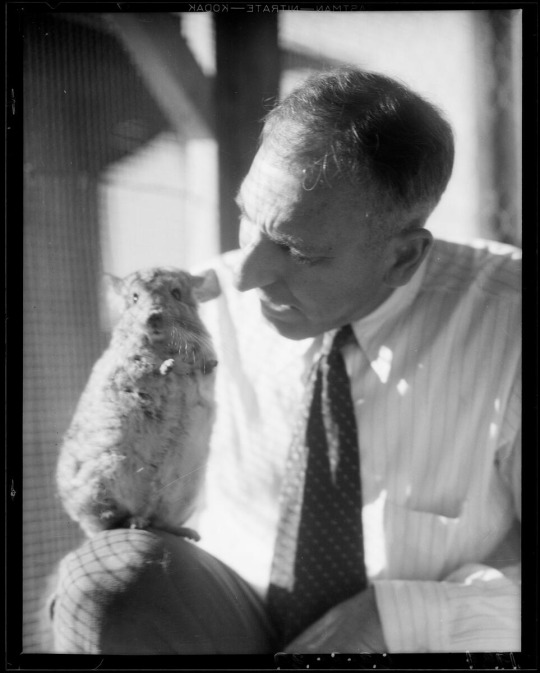
(Image: a black-and-white photo of Mathias F. Chapman, a white man with a large nose wearing a shirt and tie. A chinchilla is standing on his leg and looking at the camera while he looks at the chinchilla. End ID)
* April Fools
#april fool's day#the animal facts are real#dry beasts#dry beast monday#wet beast wednesday#chinchilla#long tailed chinchilla#short tailed chinchilla#domesticated chinchilla#rodent#mammal#biology#ecology#zoology#animal facts#informative#fur trade
117 notes
·
View notes
Note
Question: he would the hair in cat ears work for catgirls? do they get the same hair covering the ears as the rest of the head or would it be shorter for the ears only? if a catgirl has long curly hair, is the hair covering the ears also long and curly?
I would have to research that, but given I have a research subject next to me (my cat) cats do seem to have shorter hair in their ears by default, which makes sense because ears are well, ears, and they need to be mobile and clear of obstructions.

You can see here that this cat (not mine, he went away as I was writing this) has medium-length fur but the hairs covering the ears are rather short. It makes sense it would be the same for catgirls.
Now, does this mean that cat-people hair would be the same as their fur? Do notice that cat fur has a very different length and texture from human hair in that human hair doesn't have that layered thing that makes most mammal fur, individual hairs are also much longer. Furthermore, humans are WEIRD, just plain WEIRD in our hair distribution. No other mammals are like us, there are certainly hairless mammals, for sure, but the human distribution of hair is very much unlike other primates, with our hairy heads, stomach/pubic areas, beard and armpits, while those are usually bald in other primates. There is still considerable debate on the evolution of hairlesness in humans, from endothermic regulation (better sweating) to sexual selection (which might explain the persistance of, well, hair and body hair instead of complete hairlessness). What's interesting is that genes for a full fur (hair, I guess) coat in humans are still there, just disabled into vellus hairs which are a lot less prominent. If you want more on the subject, I warn you, it's a deep dive, but you can start in Wikipedia.
BACK TO CATS THOUGH, something that people often forget is that whiskers are indeed another kind of fur, but not only that, they are active sensory organs that take a big part of brains in many mammals. One we also lack. Humans are strange. But while cats can live without whiskers, it's still something very important to them. So I think that is something we forget about felines and feline characters.
It would also be a real interesting thing if cat-people had different hair, as in the thing in top of our heads (which seems to have evolved to protect our stupid big brains from the sun) similar to cat fur. Perhaps a catgirl would look pretty much human, but from touching the hair, seeing her eyes, perhaps even whiskers, you would see different stuff (assuming a fantasy or such setting). Given our genetics, it's not exactly implausible to have people whose fur just sticks to their hair and tail. It's just, well, I really need to make a post on this sort of stuff one day.
For a VERY fun deep dive into cat coat and eye genetics, I found this site full of deep explanations and charts about cat genetics. Including HYPOTHETICAL cat coats:
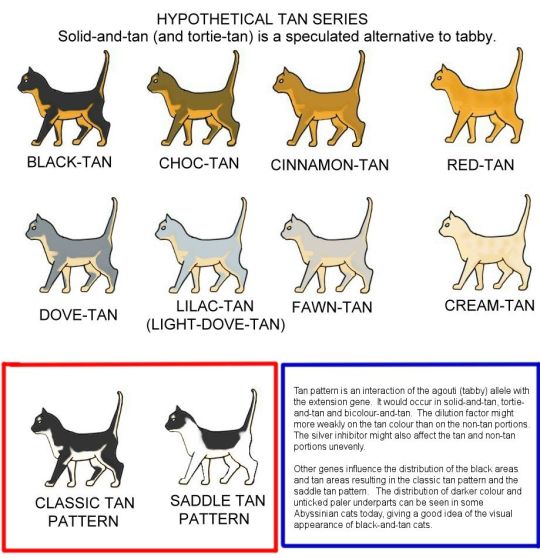
Honestly, don't miss it if you're doing cat-like characters. This is way more fun that just sticking ears and a tail and be done with it. Put the cat in catgirls again, that's what I say.
#worldbuilding#nekomimi#catgirls#cats#again I would like to thank Argentina's public university system for allowing me to get a degree so I can talk about catgirl genetics
76 notes
·
View notes